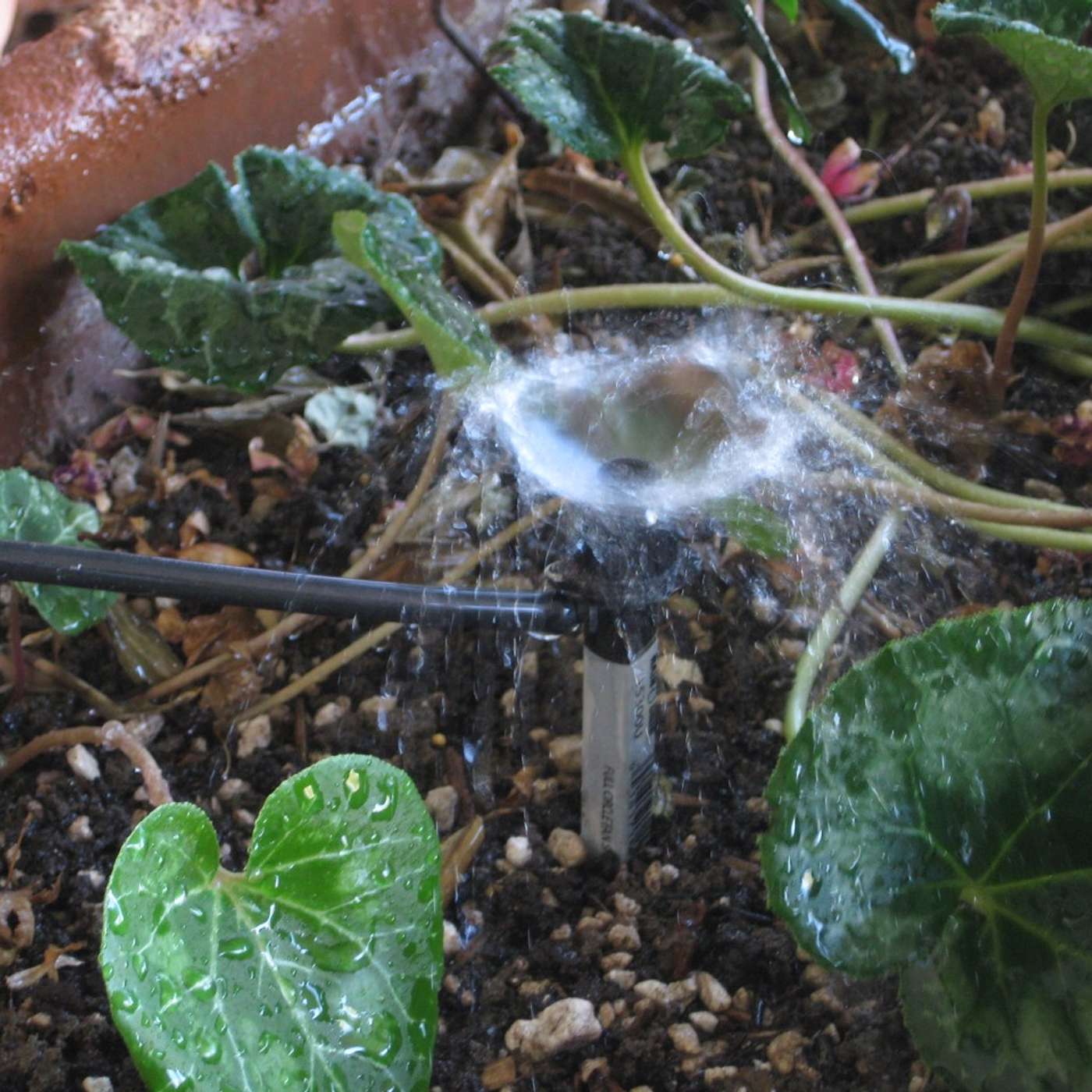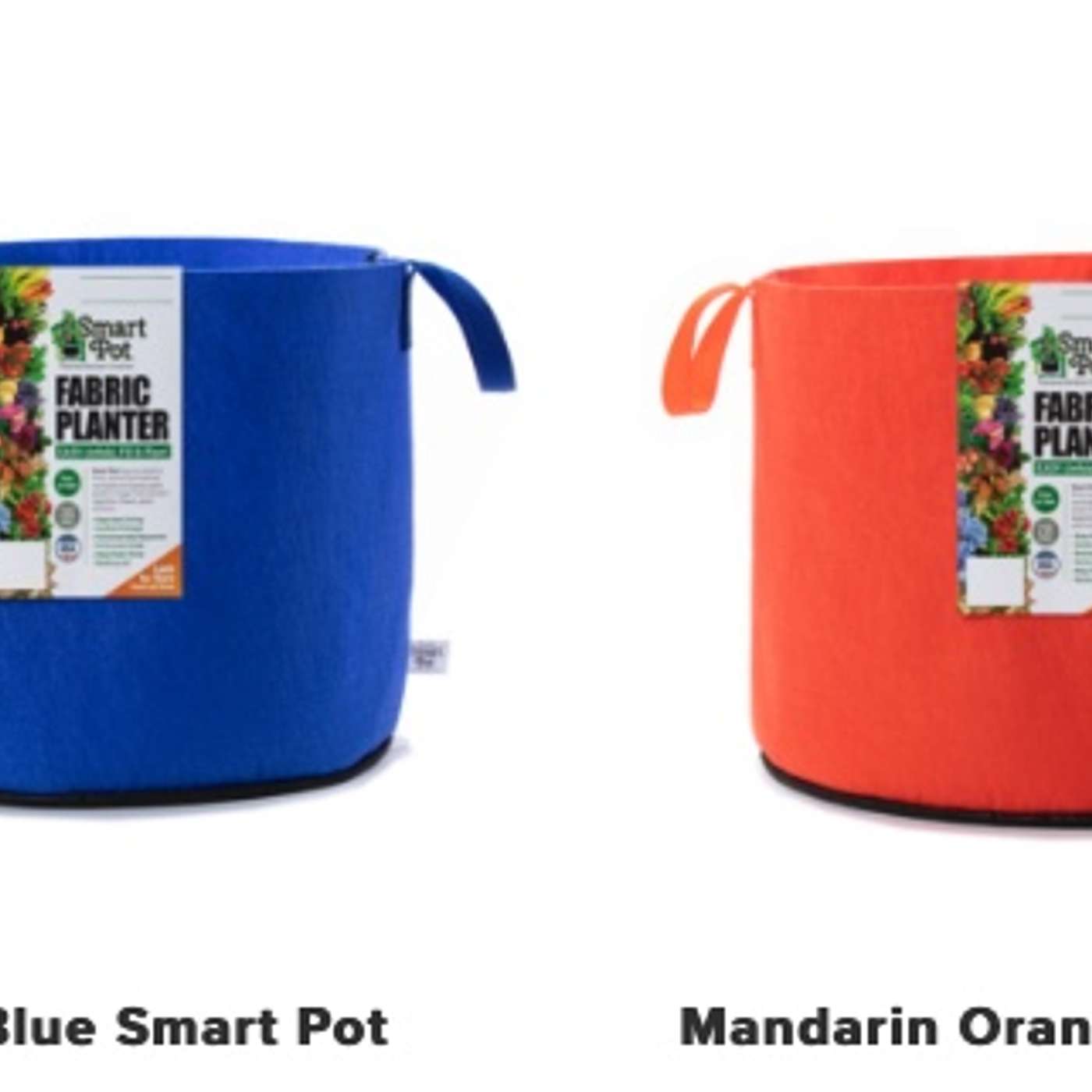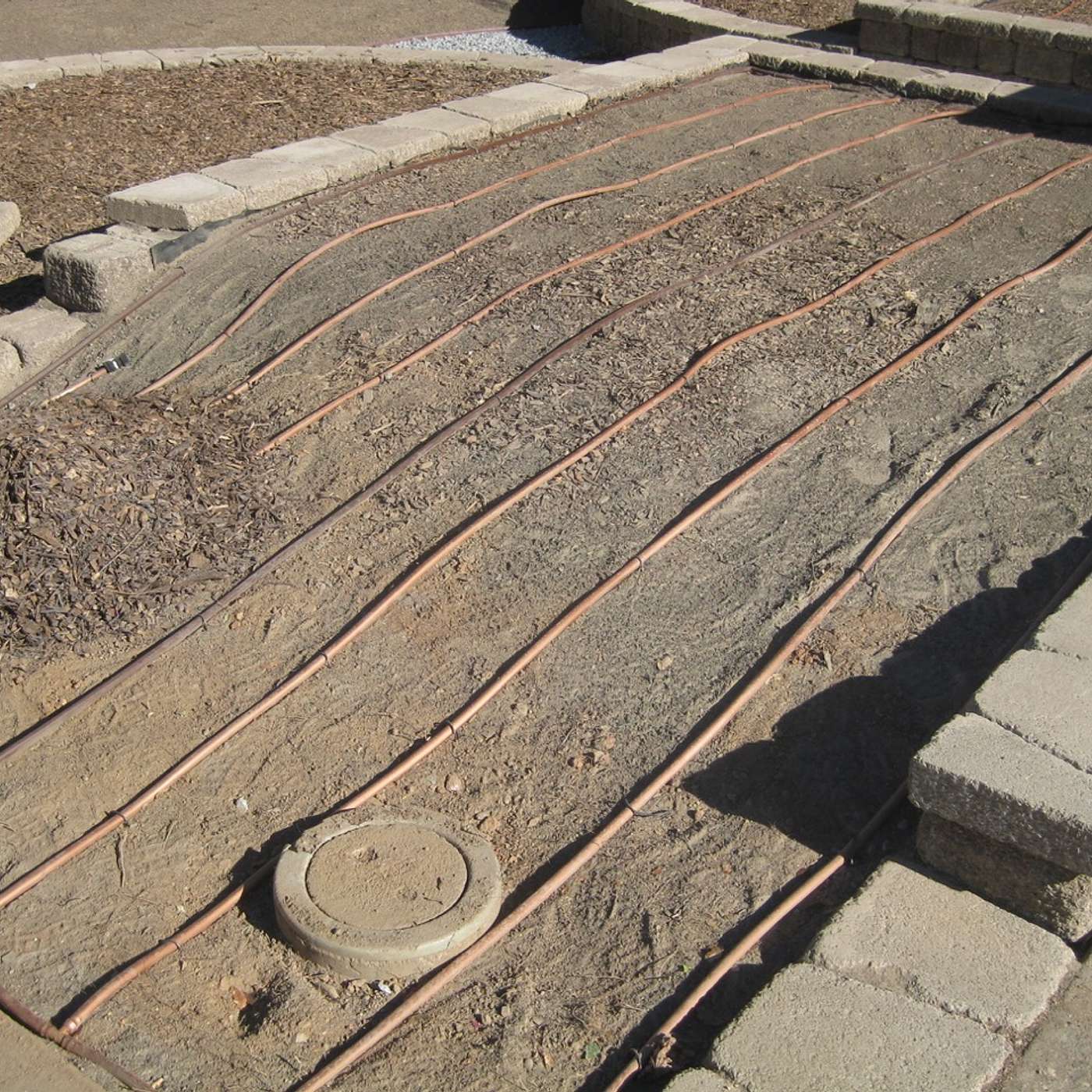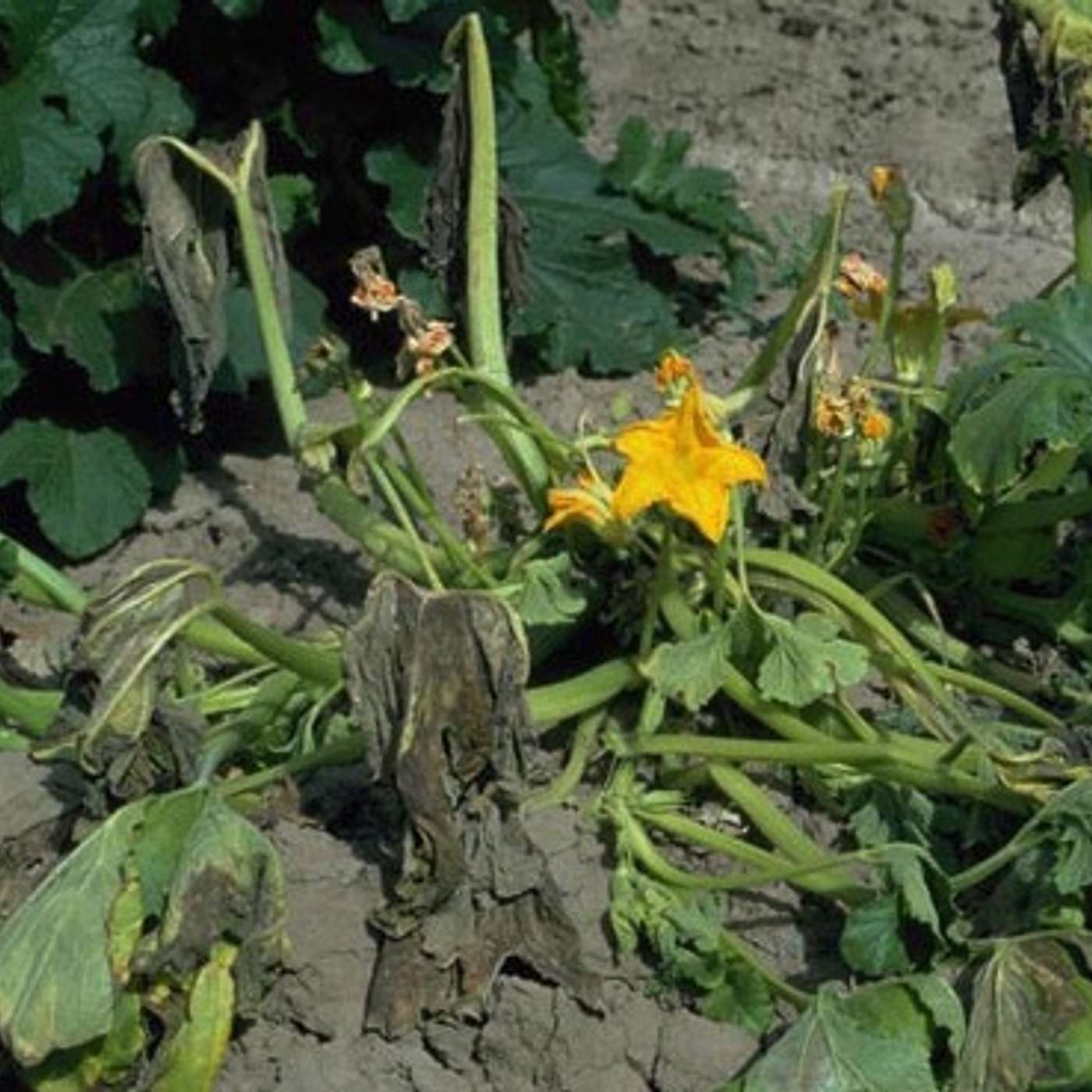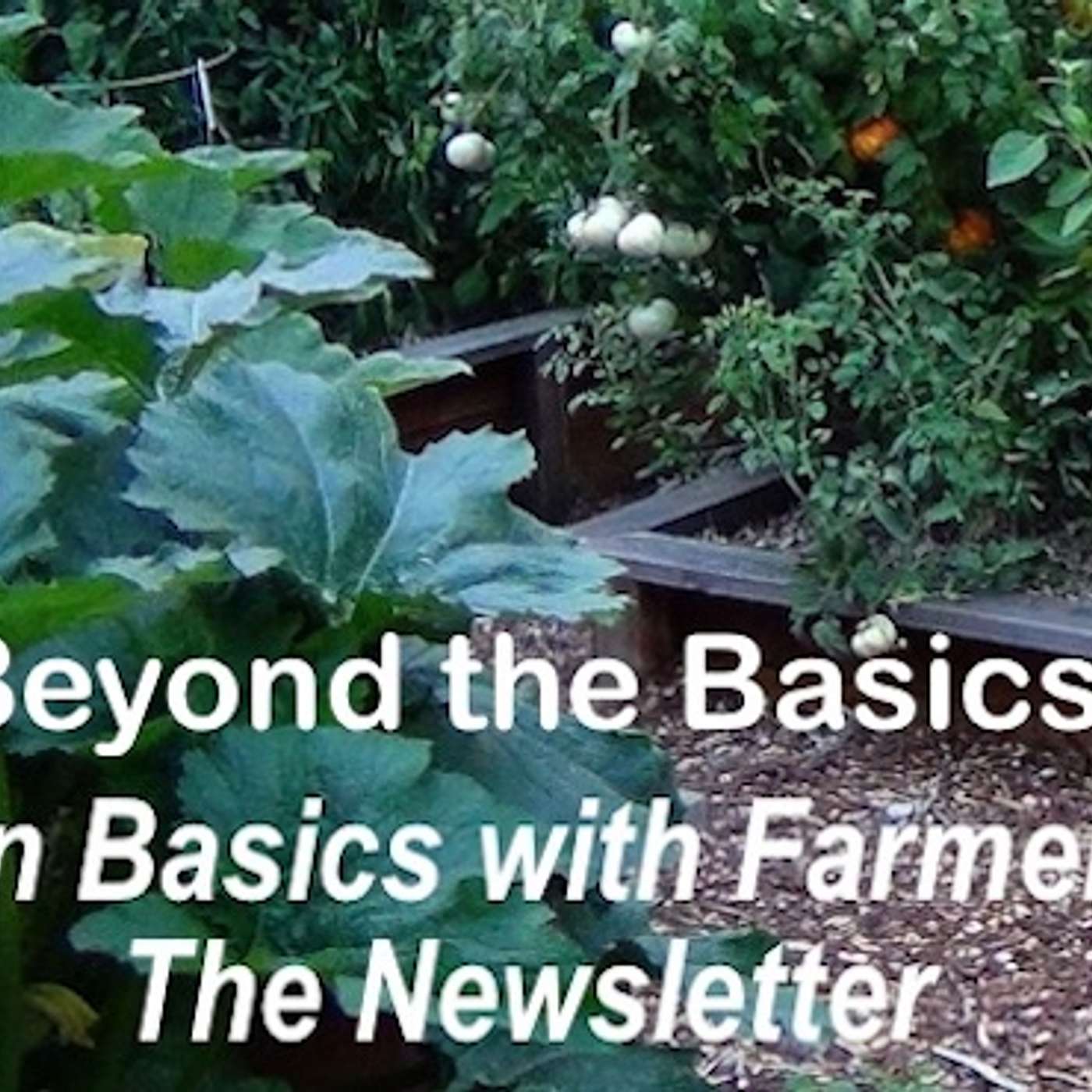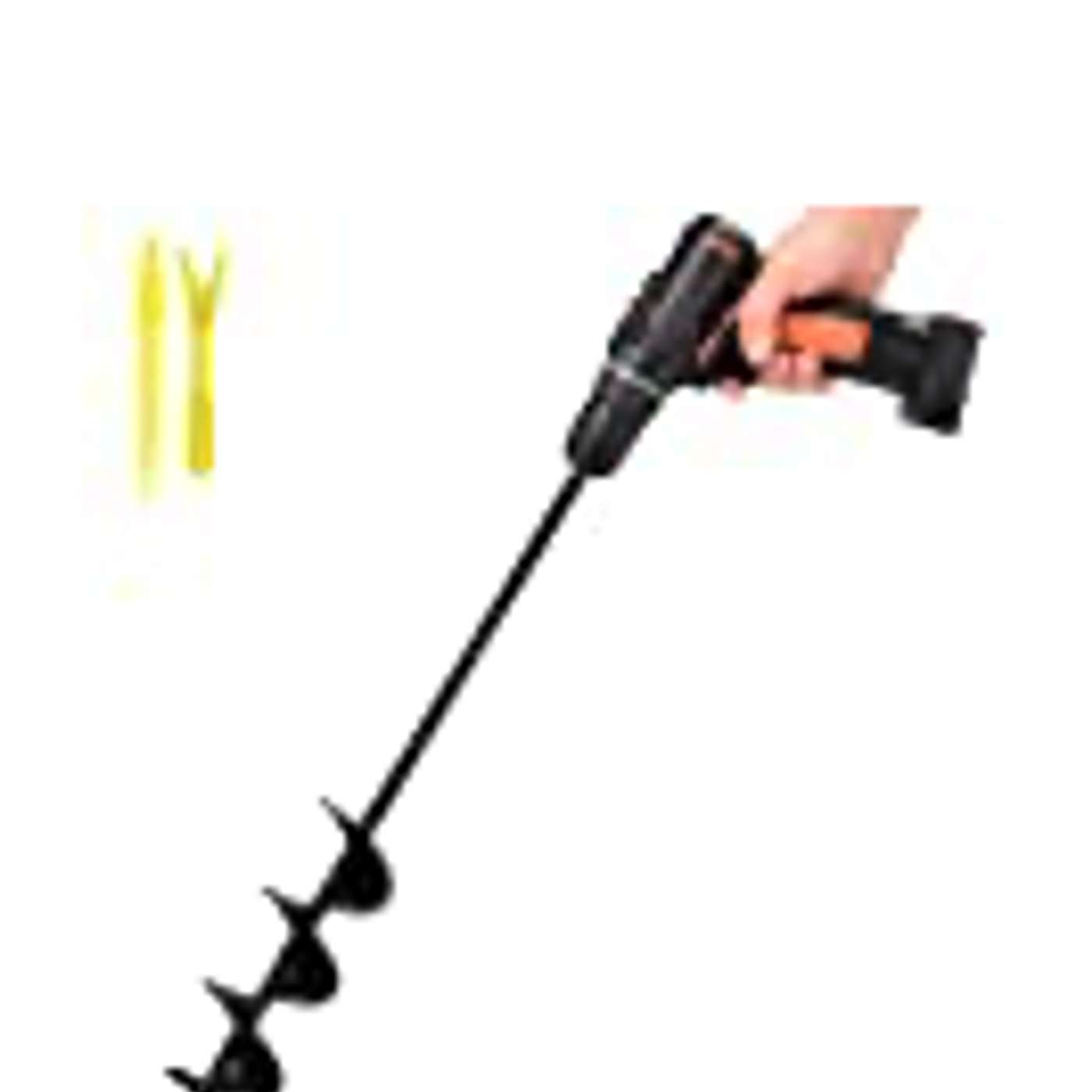Garden Basics with Farmer Fred
202 Tips, Myths About Watering Your Garden
Currently, 40% of the United States is dealing with moderate to extreme drought conditions. New outdoor watering restrictions are popping up throughout the west, southwest, intermountain regions, midwest, and the southeast. Can your garden survive with less water? Yes. In fact, if you irrigate and mulch correctly, your garden could even thrive on less water. Today we’re talking about tips and myths about efficient garden irrigation. Plus, it’s getting hot. Your plants may start looking droopy in the afternoons. But before you turn on the water give a listen to what we have to say about plants versus heat.
We’re podcasting from Barking Dog Studios here in the beautiful Abutilon Jungle in Suburban Purgatory. It’s the Garden Basics with Farmer Fred podcast, brought to you today by Smart Pots. And we will do it all in under 30 minutes. Let’s go!
Previous episodes, links, product information, and transcripts at the new home site for Garden Basics with Farmer Fred, GardenBasics.net. Transcripts and episode chapters also available at Buzzsprout
Pictured:
June 2022 U.S. Drought Map
Links:
Subscribe to the free, Beyond the Garden Basics Newsletter https://gardenbasics.substack.com
Smart Pots https://smartpots.com/fred/
Dave Wilson Nursery https://www.davewilson.com/home-garden/
Dripworks Video Series on Drip Irrigation
Drip Irrigation Kits
Soaker Hoses
Moisture Meters
Got a garden question?
• Leave an audio question without making a phone call via Speakpipe, at https://www.speakpipe.com/gardenbasics
• Call or text us the question: 916-292-8964.
• Fill out the contact box at GardenBasics.net
• E-mail: fred@farmerfred.com
All About Farmer Fred:
The GardenBasics.net website
The Garden Basics with Farmer Fred Newsletter, Beyond the Basics
https://gardenbasics.substack.com
Farmer Fred website:
http://farmerfred.com
Daily Garden tips and snark on Twitter
https://twitter.com/farmerfred
The Farmer Fred Rant! Blog
http://farmerfredrant.blogspot.com
Facebook: "Get Growing with Farmer Fred"
Instagram: farmerfredhoffman
https://www.instagram.com/farmerfredhoffman/
Farmer Fred Garden Minute Videos on YouTube
As an Amazon Associate, I earn from qualifying purchases from possible links mentioned here.
And thank you for listening.
Thank you for listening, subscribing and commenting on the Garden Basics with Farmer Fred podcast and the Beyond the Garden Basics Newsletter.
Currently, 40% of the United States is dealing with moderate to extreme drought conditions. New outdoor watering restrictions are popping up throughout the west, southwest, intermountain regions, midwest, and the southeast. Can your garden survive with less water? Yes. In fact, if you irrigate and mulch correctly, your garden could even thrive on less water. Today we’re talking about tips and myths about efficient garden irrigation. Plus, it’s getting hot. Your plants may start looking droopy in the afternoons. But before you turn on the water give a listen to what we have to say about plants versus heat.
We’re podcasting from Barking Dog Studios here in the beautiful Abutilon Jungle in Suburban Purgatory. It’s the Garden Basics with Farmer Fred podcast, brought to you today by Smart Pots. And we will do it all in under 30 minutes. Let’s go!
Previous episodes, links, product information, and transcripts at the new home site for Garden Basics with Farmer Fred, GardenBasics.net. Transcripts and episode chapters also available at Buzzsprout
Pictured:
June 2022 U.S. Drought Map
Links:
Subscribe to the free, Beyond the Garden Basics Newsletter https://gardenbasics.substack.com
Smart Pots https://smartpots.com/fred/
Dave Wilson Nursery https://www.davewilson.com/home-garden/
Dripworks Video Series on Drip Irrigation
Drip Irrigation Kits
Soaker Hoses
Moisture Meters
Got a garden question?
• Leave an audio question without making a phone call via Speakpipe, at https://www.speakpipe.com/gardenbasics
• Call or text us the question: 916-292-8964.
• Fill out the contact box at GardenBasics.net
• E-mail: fred@farmerfred.com
All About Farmer Fred:
The GardenBasics.net website
The Garden Basics with Farmer Fred Newsletter, Beyond the Basics
https://gardenbasics.substack.com
Farmer Fred website:
http://farmerfred.com
Daily Garden tips and snark on Twitter
https://twitter.com/farmerfred
The Farmer Fred Rant! Blog
http://farmerfredrant.blogspot.com
Facebook: "Get Growing with Farmer Fred"
Instagram: farmerfredhoffman
https://www.instagram.com/farmerfredhoffman/
Farmer Fred Garden Minute Videos on YouTube
As an Amazon Associate, I earn from qualifying purchases from possible links mentioned here.
And thank you for listening.
Thank you for listening, subscribing and commenting on the Garden Basics with Farmer Fred podcast and the Beyond the Garden Basics Newsletter.
GB 202 TRANSCRIPT Tips, Myths about Watering
Farmer Fred 0:00
Garden Basics with Farmer Fred is brought to you by Smart Pots, the original lightweight, long lasting fabric plant container. it's made in the USA. Visit SmartPots.com slash Fred for more information and a special discount, that's SmartPots.com/Fred. Welcome to the Garden Basics with Farmer Fred podcast. If you're just a beginning gardener or you want good gardening information, you've come to the right spot.
Farmer Fred 0:32
Currently, 40% of the United States is dealing with moderate to extreme drought conditions. New outdoor watering restrictions are popping up throughout the west, southwest, intermountain regions, midwest, and the southeast. Can your garden survive with less water? Yes. In fact, if you irrigate and mulch correctly, your garden could even thrive on less water. Today we’re talking about tips and myths about efficient garden irrigation. Plus, it’s getting hot. Your plants may start looking droopy in the afternoons. But before you turn on the water give a listen to what we have to say about plants versus heat. We’re podcasting from Barking Dog Studios here in the beautiful Abutilon Jungle in Suburban Purgatory. It’s the Garden Basics with Farmer Fred podcast, brought to you today by Smart Pots. And we will do it all in under 30 minutes. Let’s go!
Farmer Fred 1:27
Debbie Flower is here, America's favorite retired college horticultural professor. Debbie, it's springtime, and a lot of articles are coming out about vegetable gardening in newspapers. The Los Angeles Times had an article in early spring, about how to keep your vegetable garden alive this summer in a mega-drought. And that's what we have here, not only in California, but it's throughout the Southwest, and even into the inner Mountain States as well. There's a serious lack of rainfall. And people need to conserve their water. Conservation measures seem to be getting more and more strict as the weather warms up. And this Los Angeles Times article, which was, by the way, entitled, "we're in a mega drought, here's how to keep your veggie garden alive this summer" had some suggestions. Their most obvious one, of course, is one that we talk about a lot, and that's using mulch. And mulch is a good thing. They had, though, some that seemed like there could be problems attached to them. I'd like to talk about that because I have seen people do these two things.
Debbie Flower 2:37
I have seen professionals do these things when installing plants.
Farmer Fred 2:41
One of the things they suggest was large PVC pipes to send water deep into the ground, perforated PVC pipes. This person drills holes in four-inch PVC pipes, and then buries them 18 to 20 inches deep, vertically, with the top protruding above the ground. So you pour water into the pipe with a hose and you're going to be watering your roots that way, and he says that you can grow tomatoes easily that way.
Debbie Flower 3:10
There's a problem with that.
Farmer Fred 3:12
Yeah, there is a problem. There's all sorts of problems with that. First of all, digging an 18 to 20 inch deep hole that is four inches in diameter. I'm not sure unless you've got a big enough auger.
Debbie Flower 3:26
Yes, such as a fence post auger.
Farmer Fred 3:30
18 to 20 inches. You'll need a two foot drill bit to do that. And it would have to be in soil that is compatible with going down two feet easily. Because these little augers and especially the drill mounted augers, they're not going to do it right.
Debbie Flower 3:47
Two feet is quite a distance.
Farmer Fred 3:50
I've always advised that if you're going to be digging holes for planting or whatever, and you've got really poor soil, really hard clay soil, you want to bring in a guy that does it for a living. And usually their tool of choice is a two and a half to three foot diameter drill bit that is attached to the motor of their Jeep. Yeah, so they can get us some power. You need a lot of power, even the tractor mounted, PTO outlet drill bits are going to bounce up and down on clay soil. So you need something that has even more power than that. But anyway, okay, so let's say you do get these holes dug for the four inch PVC pipe with the holes. It doesn't specify where the holes are or what the diameter of the holes are.
Debbie Flower 4:41
You don't need water down 20 inches deep. I Understand that people are always wanting to get their roots deep and to get them deeper is better than more shallow for temperature regulation so that the roots are in moderate temperatures. But a much easier way to do that is to put mulch on top, to prevent the sun from hitting the soil directly. The general rule of thumb is that 90% of the feeder roots, the roots on a plant that can absorb moisture and nutrients, are in the top six inches of the soil. It's very dependent on soil type. But that's a general rule of thumb, six inches. And the reason they're that shallow is yes, they need water. But they also need oxygen. Roots do a process called respiration, which is basically breathing. It's just a part of the plant, we won't go into respiration right now. But it happens in roots as well as in other parts of the plant and the roots have to have oxygen for that. If there is no oxygen, or a limited amount of oxygen, the roots will not go deeper. All of the roots in a tree that are feeder roots are in the top three feet of soil. Once you apply water, where does it go down, gravity pulls it down, you don't need to put it at 20 inches, you need to put it where you're gonna get most of your feeder roots some water. And that's the top six inches, and then from there, it will move down into soil. Now I know people will say I have found roots deeper than three feet. Yes, plants produce roots deeper than three feet, they produce roots for stability, anchor roots, but those roots don't have the ability to absorb nutrients and don't need oxygen. Therefore, they are actually parasitic roots, they're being fed by the parts of the plant that are able to make food. Roots in general are parasitic. But some of them have a job of absorbing that water and nutrients, which helps create that food, those stability roots are just down there holding the plant in the ground. And they're not doing any absorbing.
Farmer Fred 6:40
The problem with putting all your water in a four inch pipe is you're limiting the spread, the outward spread of that water, and roots are all around the tree. So are you going to put in eight pipes? With one pipe, you're just watering one portion of one side of the tree. You want an equal amount of roots on all sides of the tree. The easiest way to do that is with a drip emitter system or a micro sprayer system where you are literally watering a circle that goes out six feet or so around the tree.
Debbie Flower 7:13
Roots go out an incredibly long distance away from the plant, the rule of thumb is they spread in all directions two and a half to three times the height of the plant. So if you have a three foot tall, and that's a short tomato plant, then the roots are gonna go four and a half to six feet away from the plant in all directions if conditions are right for root growth, and that gives them the most area to find nutrition and water. And it keeps the plant stable. If all the water is on one side roots are very opportunistic, they will grow where conditions are right for roots to grow. And so if the water is only on one side, you're only gonna have roots on one side.
Farmer Fred 7:51
So basically, I wouldn't spend my time trying to drill 20 inch deep holes and sticking a PVC pipe in it. There's a lot easier ways to do it. What about their other suggestion about digging a five gallon nursery pot into your garden to send water deep down?
Debbie Flower 8:10
That won't go as deep because a five gallon, or a number five grow pot, is about 15 inches tall. So you're only going 15 inches at most, it typically is about a foot in diameter. And there are typically drain holes on all sides, maybe four to six drain holes depending on the manufacturer of the pot. And so you're gonna get the water spread out a little better with that. If that's your only way to water, you're still not getting to those feeder roots that are in the top six inches of the soil.
Farmer Fred 8:43
Because if you're just relying on the holes that are at the bottom of that five gallon container, water doesn't tend to come back up right?
Debbie Flower 8:50
It does, incredibly slowly, like at a geological pace. Yeah, so don't count on that. Water goes down. The gardens of the native peoples in Arizona, Arizona is really, really dry. I'm talking about southern Arizona here and it's very hot for a long period of time. They relied on flood irrigation. So that puts the water right on the surface of the soil. So much so that their beds were created and it's still done in places. There's big pecan orchard down there that I visited when I worked for the University of Arizona in the plant sciences department and I still visit now and all those trees are in low spots so that the water they just flood the soil and let the water drain down. It's still done today.
Farmer Fred 9:40
What about the doughnut system, the double levee system that some people use for flood irrigation around a tree? They will build like a four inch, five inch levee in a circle, maybe six or seven or eight inches away from the trunk of the tree so you've got this you know little circle of dirt there and then further out at the outer portion of the tree, which is called the drip line of the canopy of the tree, they build another circular wall, if you will, six or seven inches and then flood the area in between.
Debbie Flower 10:11
That is for establishment irrigation. I've read a PhD thesis that talked about this, when you first plant a container grown tree in the landscape or anything else that was grown in a container, it is in container media, which is primarily organic matter. That's not what you have in your yard, or most of us do not have that kind of soil in our landscape. So somehow, those roots have to transition from the container media into the field soil. So we cut the roots to hopefully establish new tips on the roots that will grow out, we rough up the edges of the inside of the hole, so the roots have someplace to grab on to. And then we plant and we "plant proud" because that container media is going to settle. And then right around the container media only is the first of what I call a doughnut type of irrigation. So the inside of the doughnut, so the container media would be in the doughnut hole. Then you put another berm further out. When I did it, and I did, I established a whole field of shrubs this way. For my part of my thesis, we only went out another foot and put the second doughnut, the edge of the outside of the doughnut in so that there was a moat area in between the container soil that has the plant roots in it and is made up primarily organic matter. It dries out before field soil because the texture of the container soil is rougher than the texture of field soil. So you water the container soil only as much as is needed. And when I did it in a summer here at UC Davis in Davis, California, we had to water every day. And we applied only what that size container media would hold. It was a one gallon, and I think it was a liter of water that we applied to every plant. Then once a week, we watered (the entire area). So that water we put on the inside, kept that plant alive.
Debbie Flower 12:01
Once a week we water inside the berms what would be the donut that wet the field soil enough so that the roots could move out, but not so much that it was too wet for the roots, so it displaced the oxygen. That is a legitimate system for establishing plants. But once winter comes number one, you'd knock down the berms here in California, because that's when we get when we get our water, theoretically. And number two, roots will go way beyond the drip line. So you need to water for a stable tree, and you need to water way beyond the drip line.
Farmer Fred 12:37
You mentioned two things that probably needs a bit of clarification, you said to to cut back the roots. If you're planting a new plant, how far back do you cut the roots?
Debbie Flower 12:47
I shouldn't have said just cut the roots, you want to score them. And if the plant has been well grown, you don't need to go more than a quarter of an inch in.
Farmer Fred 12:56
You're talking about the root ball itself that's attached to that soil when you pop that plant out of the pot and the soil and plant are all together. That's when you migh see the roots going round and round on the outside.
Debbie Flower 13:06
Right. With a woody plant, those round and round roots will eventually kill the plant. An herbaceous plant like a tomato, it's not going to live long enough, the roots are not going to get Woody, it's not going to kill the plant. But it's an opportunity for you to create openings where behind your cut, new root tips will grow. And the root tips are the things that are going to absorb the water and nutrition.
Farmer Fred 13:27
Alright, so basically you're just scraping your fingernails, right?
Debbie Flower 13:31
Yeah, people talk about teasing the roots or scraping the roots, right.
Farmer Fred 13:35
All right. Now you also use the term "plant proud".
Debbie Flower 13:39
"Plant proud" means that the container soil should stick out of the field soil. From a little four inch pot, it might just be for half an inch. If you're planting a gallon, I'd say the container soil should stick out an inch, inch and a half. If you're going to planting from a number five, you're going to stick out several inches, three inches maybe, and then you mulch up to it so that if you're using the berm, the berm acts as the mulch up to it. But if you're not you mulch up to it so it doesn't dry out, but it will sink over time as it breaks down.
Farmer Fred 14:09
One way to ascertain the correct amount is to put a shovel handle across that hole that you dug, and then put your plant in. Where does that top of that container mix lie in relation to that shovel handle? If you wanted an inch or two above that shovel handle, you'll probably have to lift the plant out, put some more soil at the bottom of the hole and then reset it.
Debbie Flower 14:30
It's a big problem if you dig your holes too deeply. My husband had a tendency to do that for quite a while. Then they become the low spot and when you irrigate or we get rain, it becomes a puddle around the base of the plant. You can introduce disease that way, you can drown the plant that way, or lots of organic matter blows in and eventually the plant ends up being buried too deeply.
Farmer Fred 14:52
Husbands always get the blame.
Debbie Flower 14:55
Oh, I make a lot of mistakes too.
Farmer Fred 14:59
Yes, there is a drought for many of us, but you can still have a garden. And in fact, in many areas here in California, the water agencies are going out of their way to say you got to keep the trees, you got to keep the trees. And even though you might be killing the lawn around the trees, with a lack of water, you got to make sure your trees get water.
Debbie Flower 15:17
The trees don't need the same frequency of irrigation that the lawn does. And lawns can go brown and they can recover. I was super surprised when I moved west, and lawns were green all year round because I lived in a place where frost would kill lawn, so there was always a period of brown. It just didn't make sense to me. So yes, accept that aesthetic that you should have a brown lawn for a period of the year.
Farmer Fred 15:40
Yeah, this isn't the episode to get into the future of lawns, but I don't see big lawns in our future.
Debbie Flower 15:46
Right. And it seems to be more people seem to be accepting that fact.
Farmer Fred 15:52
Yeah. Oh, and that's a battle. Okay, where were we? Mega-drought, there are ways to mitigate the effects of a lack of water falling from the sky. Basically, open up your wallet and pay more for water.
Debbie Flower 16:05
Yeah, but water is surprisingly cheap.
Farmer Fred 16:08
Yeah. And so is mulch.
Debbie Flower 16:10
Yes, yes. Free. In fact,
Farmer Fred 16:12
Yeah. So consider that as part of your water saving efforts. Debbie Flower. Thanks for saving us some water here.
Debbie Flower 16:19
You're welcome, Fred.
Farmer Fred 16:24
I’m pretty picky about who I allow to advertise on this podcast. My criteria, though, is pretty simple: it has to be a product I like, a product I use, and a product I would buy again. Smart Pots checks all those boxes. Smart Pots is the oldest, and still the best, of all the fabric plant containers that you might find. Smart Pots are sold around the world and are proudly made, 100%, here in the USA. Smart Pots come in a wide array of sizes and colors, and can be reused year after year. Some models even have handles, to make them easier to move around the yard. Because the fabric breathes, Smart Pots are better suited than plastic pots, especially for hot environments. That breathable fabric has other benefits, too. Water drainage issues? Not with Smart Pots. Roots that go round and round, chocking the rootball, like they do in plastic pots? Doesn’t happen with Smart Pots. These benefits will help you get a bigger better plant than what you have gotten in the past with the same size plastic or other hard container. Smart Pots are available at independent garden centers and select Ace and True Value hardware stores nationwide. To find a store near you, or to buy online, visit smart pots dot com slash fred. And don’t forget that slash Fred part. On that page are details about how, for a limited time, you can get 10 percent off your Smart Pot order by using the coupon code, fred. f-r-e-d, at checkout from the Smart Pot Store. Visit smartpots.com slash fred for more information about the complete line of Smart pots lightweight, colorful, award winning fabric containers and don’t forget that special Farmer Fred 10 percent discount. Smart Pots - the original, award winning fabric planter. Go to smart pots dot com slash fred.
Farmer Fred 18:19
We get a lot of questions about drip irrigation on this program and it can lead to drip irritation. One question, and we get a lot of this, is: How many emitters do I need for my garden? Very good question. Garden author Robert Kourik wrote about that in his book, "Drip Irrigation for Every Landscape and All Climates". And here's his formula for the number of emitters you need for gardening, especially in raised beds:
Robert Kourik 18:47
I tried to use the equivalent of one emitter for every square foot. I use inline emitter tubing where the emitters are built inside the tubing. But they have to be pre-installed every 12-18-24 inches depending on what you buy. So I use inline emitter tubing where the emitters are every 12 inches. On a three foot wide bed I can get away with just two tubes. But on a four foot wide bed I put four tubes for parallel lines a whole length of the bed.
Farmer Fred 19:20
The searing summer heat has returned to our area with a vengeance. Several consecutive days of 100 plus readings can sap the strength of area gardeners, while wilting or killing under watered plants. So this week's Things To Do list we're talking about heat versus your plants or your plants starting to wilt in the afternoon. Well wilting is a natural defense mechanism used by many plants during hot afternoons to conserve water. If you're worried about when you see wilting, dig down about six to eight inches and check the soil moisture or use a moisture meter. Add water only if moisture is absent around the root zone of the plant at that depth. However, when you see a wilting tomatovine, coleus or fuchsia in the morning, that's when you know your plants probably do need a good long drink of water. Mornings are the best time for both humans and plants during heatwaves to take care of weather related outdoor garden problems. As you enjoy the briefly cool early hours outside, keep some of these hot weather garden tips in mind. Even during heat waves, lawns and gardens don't need to be watered every day, two or three times a week is plenty. newly planted annuals and emerging seedlings though have shallower roots, so new seed beds and young plants may need a daily irrigation. Containerized plants in the sun probably need watering every day during heat waves as well. Raise the containers off the ground with a plant stand or a couple of pieces of wood or bricks. This will help keep the pot cooler by improving air circulation. Another tip for protecting your potted plants in the full sun: If you have bigger empty pots hanging around, consider putting the smaller potted plant inside that bigger empty container. Insert mulch between the larger pot and the smaller pot to reduce the heat from the sun even more, or surround the potted plant that's in full sun with other pots or even lined them with paper bags on the outside to reflect the heat of the sun. There is a downside of daily watering of potted plants. Fertilizer is being leached out of the soil more quickly. So instead of a once a month feeding regimen. Fertilize plants in pots every two weeks. Just be sure to cut the fertilizer dosage in half during extended heatwaves. If you're going on vacation, consider grouping containerized or hanging plants on the cooler side of the house such as the north or the east side. Mulch can help you out a lot. A four inch layer of bark mulch applied beneath the canopy of trees and shrubs will help conserve water, control weed germination, and keep the soil cooler. Just because it's hot don't love your drought tolerant California native plants to death with too much water. California natives like Ceanothus or oak trees, especially the Blue Oak, prefer it on the dry side in the summer. A once a month watering is plenty for them this time of year. And again, I can't stress this enough, don't let the dry surface of the topsoil fool you. Check the soil moisture down at the root zone six to eight inches deep. If it's only the top few inches that are dry and your established plants look healthy, fight that urge to waterlog those roots. If you're traveling about and one of your stops includes the local nursery or garden center, make it the last stop of the day. A plant that's left in a hot car for as little as 15 minutes may stress it beyond recovery. And, you too, try to stay cool.
Farmer Fred 22:57
One of my favorite aisles at the big hardware stores is the drip irrigation aisle. It’s almost like a church in that space. People are silently staring, straight ahead at the morass of bins containing strange looking drip irrigation parts…and those people are more than likely praying for guidance that they can unravel the mysteries surrounding drip irrigation. In Friday’s Beyond the Basics newsletter, we try to guide you to the right bin so that drip irrigation, a very efficient way to water your plants, doesn’t become drip irritation. Well, at least we attempt to try to manage your irritation. It’s inevitable. In Friday’s combination of newsletter and podcast, we talk with garden author Robert Kourik who literally wrote the book about drip irrigation. In the newsletter portion, I’ll show you some of the best options available for irrigating your plants with less water. It’s in the newsletter that goes beyond the basics, the Garden Basics with Farmer Fred, Beyond the Basics newsletter, out Friday, June 17th. Find it via the link in today’s show notes, or visit our new website, Garden Basics dot net. There, you can find a link to the newsletter in the tabs on the top of the page. Also, you can listen to any of our previous editions of the podcast, as well as read an enhanced transcript of the podcast episode you are now listening to. That’s at Garden Basics dot net, where you can also link to the Garden Basics newsletter, Beyond the Basics. And it’s free. Look for it on Friday, June 17th. Take a deeper dive into gardening, with the Beyond the Garden Basics newsletter. Find it at garden basics dot net.
Farmer Fred 24:46
Let's go to the Garden Basics mailbag. Here's a question sent to Fred at farmerfred.com. Well, it's not a question. It's a drought comment. It comes from David and he has a different way of measuring the amount of water that your soil may need. We've talked in the past about using a trowel, a soil probe tube, or a moisture meter to determine if the root zone of your plants, at about eight inches below the soil surface, needs water. And David writes in and says, "My solution to determining soil moisture before I water the lawn and garden is to use a 12 inch long,quarter inch diameter drill bit on a cordless drill. If the soil is dry, the dust does not stick in the tines. If there is soil sticking in the tines, the soil is probably moist enough so there's no need to water. It just takes a few minutes of practice to learn to read it." Thank you for that, David. If you have rocky soil or really hard clay soil using a 12 inch drill bit with a cordless drill and you're trying to go down eight inches, that may be kind of difficult. Good luck. If you've got a garden tip you'd like to share, send us an email to, Fred at farmerfred.com.
Farmer Fred 25:59
Garden Basics With Farmer Fred comes out every Tuesday and Friday and is brought to you by Smart Pots and Dave Wilson Nursery. Garden Basics is available wherever podcasts are handed out. For more information about the podcast, visit our website, GardenBasics dot net. That’s where you can find out about the free, Garden Basics newsletter, Beyond the Basics. And thank you so much for listening.
